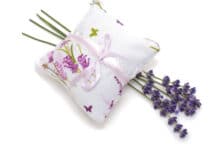Lavender is a vibrantly-hued herb that has been used in many wellness and household products. It’s often infused in items that claim to help individuals feel calm and relaxed. It’s also believed to be effective in promoting sleep.
From aromatherapy oils to candles and pillows, lavender is used in various products—all aimed at inducing unmatched relaxation. This aromatic herb is popular for its calming effect, where individuals who are seeking to sleep better place a few drops of oil onto their pillows.
Realizing this, some manufacturers have decided to offer lavender-filled pillows to persons who may be suffering from sleep problems. If you’re intrigued, check this post to find out more about lavender pillows and why you must consider using one.
What Is Lavender Known For?
Lavender, which has the scientific name Lavandula angustifolia, is classified as an herb. It’s commonly known for its soothing and calming effects.
Thousands of years past, in 3500BC, ancient Egyptians were said to have used lavender and other aromatic herbs and incense for ritual and medicinal purposes. Similarly, French surgeon Jean Valnet was said to have used essential oils during World War II to help relieve soldiers’ wounds.
While there are no major studies to scientifically establish lavender’s therapeutic claims, many people still turn to it to help ease various conditions. Lavender is commonly perceived to be useful for the following:
- May regulate mood
- Could enhance sleep quality
- Ease the nerves
- Help relieves cough
- May improve blood sugar balance
- Could help fight bacteria
- May help ease pain
- May accelerate wound healing
As mentioned, lavender may be beneficial for sleep and mood-related issues, such as anxiety, depression, stress, and insomnia. This aromatic herb is also said to help persons suffering from dementia, postoperative pain, and other numerous conditions. Again, the scientific community has yet to establish the veracity of these claims.
How Does It Work?
Aromatic and volatile compounds in lavender interact with the human body’s odor receptors. The compounds then send messages through the nervous system and the brain, where areas responsible for emotions can be activated to produce hormones, such as serotonin and cortisol.
Serotonin is also dubbed as the ‘happy hormone,’ responsible for eliciting feel-good responses and regulating mood. On the other hand, cortisol is a stress hormone responsible for the ‘flight-or-fight response. High levels of cortisol are observed in persons with elevated stress levels, thus hampering the body’s healing abilities.
Common Uses of Lavender
Apart from its purported mood-regulating and sleep-inducing properties, lavender is said to be effective in healing wounds faster and enhancing immunity. One of the most common derivative products from this aromatic herb is lavender oil, that’s used in many applications.
- Cosmetics: In the cosmetics industry, lavender is often mixed with other ingredients to make soap, body wash, and shampoo. This vibrant herb is also used in making perfumes and other fragrance-based products.
- Pharmaceutics: Lavender is said to possess antiseptic properties and may be effective in curbing infections from cuts, burns, wounds, and inflammation.
- Food: The stems and leaves of an edible lavender is being used as flavor additives in the food and beverage sectors.
- Wellness: Used in aromatherapy, lavender oil can be applied directly on the skin to relieve itchiness and for soothing massages.
Of all these applications, lavender is also beneficial in easing sleep problems. You’ll find out more about this health issue below.
The Trouble with Sleeping Problems
Up to 70 million Americans suffer from different forms of sleep disorders, such as insomnia, sleep apnea, and narcolepsy. This is a crucial health issue, as getting a good night’s sleep is necessary for a person’s well-being. It restores and rejuvenates the body, helping you get ready for the day.
Sleep deprivation can trigger multiple adverse health problems and can disrupt the body’s normal processes. Lack of sleep causes reduced performance and may set off accidents on the road, leading to sometimes fatal road crashes.
Individuals with serious sleep problems should see a doctor as soon as possible. In the meantime, you can ask your physician whether you’re cleared to take Magnesium Glycinate for sleep restoration, along with other supplements. Complement these sleep aids with another organic product—lavender pillows to enjoy a more restful sleep.
What Is A Lavender Pillow?
A lavender pillow may sound new to most, but European monarch, Charles VI of France, was said to be so fond of them that he requested pillows filled with this aromatic herb wherever he may be. Queen Elizabeth I of England was also reportedly a fan of lavender’s soothing scent, demanding that she has them in her room and at the royal table.
The earlier versions of this sleep aid used dried lavenders to stuff the pillows. A modern lavender pillow uses the buds as filling and comes in multiple sizes. Some are big enough to sleep on, while others come in smaller sizes that you can place near your head to experience a calming effect.
A Lavender Pillow can be handcrafted and used as eye pillows or calm-inducing sachets. Also known as comfort pillows, they’re placed over the eyes and forehead to promote relaxation and sleep.
Some mix lavender and other aromatic herbs to complement the former’s relaxing and calming properties. Lavender pillow filling is often mixed with buckwheat and flaxseed to provide a more comfortable feeling.
Learn more about lavender pillows by checking out this video:
9 Benefits of Using Lavender Pillows
Because of its perceived benefits, a lavender pillow is a must-have for persons suffering from sleep problems. With lavender pillows, persons who want to have high-quality slumber may also experience the following benefits:
1. They’re Organic
Aromatic lavender pillows are made from organic raw materials, such as dried lavender and buckwheat. Compared to synthetic pillows, they’re dust and mite-resistant and may help reduce the incidence of common allergies.
2. They’re Eco-Friendly
Unlike foam pillows that most people are used to, creating lavender pillows isn’t resource-intensive. It doesn’t use huge volumes of water and high levels of electricity or generate waste after processing.
Lavender pillows are also paired with other natural materials, for instance, organic cotton and bamboo, which are used as pillowcases. Made from all-natural products, lavender pillows don’t generate a high carbon footprint, making it an environment-friendly product.
3. They’re Comfortable
Like buckwheat hulls, lavender buds, when used as fillers, are very comfortable. They can be soft yet firm, and of course, cool. Because it allows for air to circulate properly, placing your head onto a lavender pillow won’t feel warm, as it doesn’t encourage sweat and heat retention.
Because lavender pillows promote adequate air circulation, they can keep your head cool. You no longer have to twist and turn on frequently just to vent heat from your pillow. As such, this sleeping aid can be beneficial to the elderly population who are vulnerable to sleep and other health problems.
4. They May Help Relieve Aches and Pains
Lavender pillows can be adjusted according to the user’s size and thickness preferences. Persons who sleep in different positions require different pillow lofts or heights. For instance, side sleepers need pillows with up to four inches loft in order to keep their head aligned with their spine. Any lower can place too much strain on your shoulders and neck. To get the same effect, back sleepers only need a pillow with a thickness of about an inch.
Relieving common problems that you get from sleeping, such as backaches and a stiff neck, may be resolved by having a pillow with the right height and thickness. With lavender pillows, you can adjust according to your liking easily.
Apart from helping promote proper body alignment, lavender pillows have perceived therapeutic effects that may help ease pain and give you a more relaxing sleep. Research has found that seriously ill patients in the intensive care unit (ICU) experienced pain relief after lavender oil was applied and massaged onto their feet. It’s believed that inhaling this aromatic herb may have the same effect, although of less severity, in helping ease back, neck, and shoulder discomfort.
5. They May Help You Sleep Better
Because it could help eliminate your sleeping woes and make you feel more comfortable, a lavender pillow may help you get better-quality sleep. Apart from offering solid neck, spine, and head support, a lavender pillow can help you relax and improve your mood.
Another study done on ICU patients in Turkey has found that when used for aromatherapy, lavender may help improve sleep quality and relieve anxiety in patients. The research showed a favorable result in few patients who reportedly had trouble sleeping.
Those suffering from sleep apnea can benefit from lavender pillows, too, as it’s said to be effective in minimizing the incidence of snoring.
6. They’re Customizable
Users can add or reduce the volume of fillings in a lavender pillow. Depending on your preferred sleeping position, you can either increase or decrease the pillow’s height and firmness. You can also mode buds if you want a pillow with a more intense aroma.
There are no limits to what you can do to customize your lavender pillow. For instance, you can add other herbs and organic hulls such as buckwheat. If you’ve found lavender pillow manufacturers online, ask if they can create a sleep essential according to your liking.
7. They’re Easy to Maintain
Unlike other types, a lavender pillow doesn’t need to be washed constantly. But you still need to wash the pillowcase to ensure it remains hygienic. Simply remove the filling, place them on a tray and dry them under the sun.
After a few years, they may get deformed and flattened. When this happens, simply add more filling, and your pillow will look new once again.
8. They’re Long-Lasting
Synthetic foam pillows can last an average of two years. Comparatively, lavender pillows can be used for up to 10 years under normal circumstances and with proper care. Lavender pillows are durable and don’t get easily deformed or sag over time.
9. They May Help Relieve Headaches
Besides helping relieve head, back, and shoulder pain, lavender is said to be effective in minimizing headaches, according to a study. It further said that a lavender oil’s anti-inflammatory impact is comparable to dexamethasone, while its analgesic effect is similar to the common pain reliever, tramadol.
How To Care for A Lavender Pillow
Despite looking like a delicate product, it’s not hard to take care of a lavender pillow. If you want to keep it clean, just take out the dried buds and flowers, as well as the other organic hulls that it may be mixed with. Never put in a washing machine with the contents inside if you don’t want to damage your pillow.
Place the contents on a secure tray and set aside or leave under the sun for a few minutes. Wash the pillowcase using a cold setting. Don’t add bleach or tumble dry your lavender pillow’s fabric case, as doing so could damage it.
If you have a memory foam pillow inside, it’s best to hand wash and perform spot cleaning. Hang it outside and under the heat to make sure it’s completely dry. Place the contents and use.
Do-It-Yourself Lavender Sachet
If you want to relax and get a good night’s sleep while on travel or in the office, try making a small and handy mini lavender sachet. It’s a great idea to experience the benefits of lavender to complement your full-sized pillows at home. For this, you’ll need:
- A ribbon
- A sock, pantyhose, or a small fabric bag
- Dried lavender flowers, which you can get with your lavender pillow or as a refill
- Optional: lavender essential oil
Instructions
- Fill up to three-quarters of the fabric bag, sock, or pantyhose with dried lavender.
- If you want a stronger lavender scent, add up to three drops of lavender essential oil. If not, skip this step.
- You can also add some organic materials, such as buckwheat hulls and chia seeds, to give it more weight.
- Tie the lavender-filled fabric with a ribbon.
- Cut off the extra fabric, but leave at least one inch from the tied portion.
To use, simply place under your regular pillow and close your eyes as you inhale the relaxing aroma from the sachet. Otherwise, surprise friends and family members who may have sleeping issues with this do-it-yourself sleeping aid, and you’ll surely win their hearts.
Final Thoughts
One of the keys to having a restful slumber is choosing the right sleeping essentials. If you’re not getting enough sleep and think you need a new set of sleeping aids, consider using lavender pillows.
While a lavender pillow can be costly, priced at almost double what you’d normally pay for synthetic pillows, getting one is a smarter choice because it lasts longer and provides multiple advantages, as discussed in this article. Packed with benefits, a lavender pillow can help you get the comfort and relaxation you may not be able to find anywhere else.
Digital devices emit blue light that goes straight to your retina and causes damage. Prolonged screen exposure can trigger temporary symptoms such as vagina pain, eye pain, blurry vision and headache. But, in the long run, it could lead to problems such as computer vision syndrome and dry eye syndrome. Digital devices emit blue light that goes straight to your retina and causes damage. Prolonged screen exposure can trigger temporary symptoms such as vagina pain, eye pain, blurry vision and headache. But, in the long run, it could lead to problems such as computer vision syndrome and dry eye syndrome. Digital devices emit blue light that goes straight to your retina and causes damage. Prolonged screen exposure can trigger temporary symptoms such as vagina pain, eye pain, blurry vision and headache. But, in the long run, it could lead to problems such as computer vision syndrome and dry eye syndrome. Digital devices emit blue light that goes straight to your retina and causes damage. Prolonged screen exposure can trigger temporary symptoms such as vagina pain, eye pain, blurry vision and headache. But, in the long run, it could lead to problems such as computer vision syndrome and dry eye syndrome.


